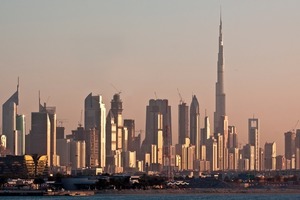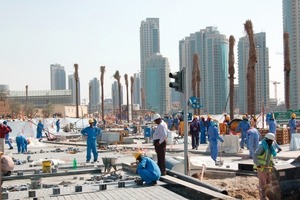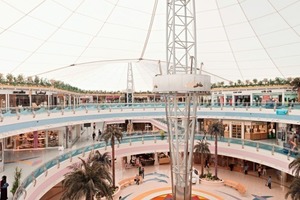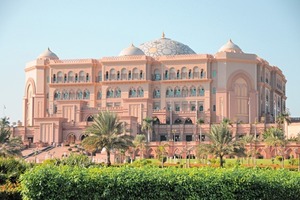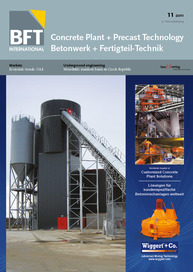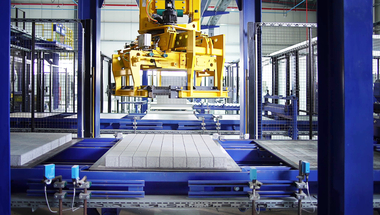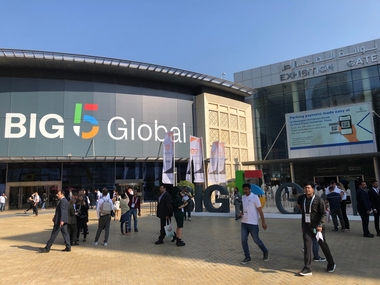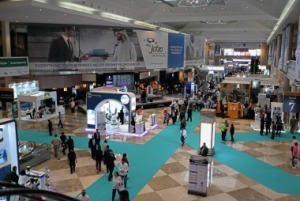United Arab Emirates
According to forecasts, the UAE will again reach the imports level of the unprecedented boom year of 2008 in 2012 at the latest. Abu Dhabi has got the necessary petrodollars to continue many of its ambitious major projects whereas Dubai is one of the winners of the political crisis in the Arab region. The city is a safe, liberal, attractive and – in the meantime – less expensive place to do business on the Arabian Peninsula whose advantages in terms of logistics and tourism are very hard to achieve for any other place in the region.
General economic outlook
After a 1.6% decline in 2009, the UAE have again embarked on a growth path and should expect to achieve incremental real GDP growth in the coming years. From 2013, the Economist Intelligence Unit in the UK even anticipates GDP growth rates of 5% or more. These projections rely on figures published by the new National Bureau of Statistics, which is to consolidate the surveys conducted by the individual Emirates and adjust historic figures. According to observers, the new GDP figures are more realistic than the old, somewhat exaggerated statistics. This being said, however, skepticism is still in order.
As in past periods, growth is still being driven by the oil and gas industry. However, the central government and the individual Emirates strive to create a broader basis for the economy, which is being achieved by considerable investment in infrastructure, industry and services. Whereas previous periods were mainly characterized by a focus on economic diversification and anticipated profits, current measures also include activities to create jobs for the Emirates‘ local population and an appeasement policy. For instance, the Abu Dhabi Urban Planning Council awarded contracts for the construction of 7,500 villas for local families, each at a price of US$1 million, on the occasion of the Cityscape real estate show in April 2011. In addition, there are comprehensive plans for other urban projects. Also, the central government located in Abu Dhabi intends to support the less wealthy, strongly neglected northern Emirates and to ensure sufficient electricity and water supply.
Dubai, however, has defined slightly different priorities, beginning with its debt service that can be continued successfully in the next few years only if spending is cut and income is increased. For this reason, the Emirate is reverting to its traditional strengths, i.e. trade and tourism. This move is supported by the general political climate in the Arab world. The regional offices of major international corporations in the logistics city have relocated a considerable number of foreign staff from Tunisia, Libya, Egypt, Bahrain and Syria to Dubai. At the same time, many Arab visitors, mainly from Saudi Arabia, now come to Dubai whereas they previously went on vacation to Egypt, Bahrain or Syria. Overall, this is a very lucrative business generating the earnings necessary to continue and complete commenced hotels, shopping malls and other tourism-related projects.
As of 10 May 2011, the MEED project tracker stated a total amount of US$641 billion for planned or commenced investment projects in the UAE, which is slightly lower than in Saudi Arabia and 35.5% less than just a year ago. Yet even this reduced amount should still fund a number of very ambitious projects that are officially being “continued” although work is progressing at “snail” speed, or not at all. More representative are the MEED statistics for projects or parts thereof in the bidding phase (currently 121 projects equivalent to a total investment of US$59 billion) or for those projects that have already reached the design phase, including front-end engineering and design (73 projects worth US$102 billion).
In the meantime, a second investment trend has emerged that is less spectacular but highly interesting nonetheless: an increasing number of businesses from the Arab world is interested in establishing a company in the UAE, triggered by the relatively low country risk of the Emirates compared to other countries in the region. Even trading companies not doing business with Arab countries at all consider the UAE (more specifically, Dubai) increasingly interesting: as a logistics alternative, the city is much more attractive than, for instance, Karachi in Pakistan or Mumbai in India.
When deciding upon their market entry, potential investors and companies wishing to export goods to the UAE should consider the strengths and weaknesses of the country and the associated opportunities and threats (SWOT analysis):
Private household spending is being fueled by continuously high public spending – particularly in Abu Dhabi – and restored consumer confidence. As part of an appeasement policy, larger amounts are redistributed to the local population, which is known to be directly beneficial to consumption. The resurgent interest in Dubai as a “safe” logistics hub led to an increase in the number of foreign employees after a net decline in 2009.
The services sector – in particular hotels and restaurants and big shopping malls – is again attracting a large number of interested parties, benefiting from the problems in other countries in the region. Due to reduced rents, inflation remains at a relatively low level and is officially stated at 0.9% for 2010. With a view to the recovered world economy and especially higher food prices, the level of currency devaluation should again rise to 2.5% in 2011, which would still be relatively sound compared to other countries in the region (Saudi Arabia 2011 forecast: 6.0%; Qatar: 7.4%). However, the official inflation rate of the UAE is not particularly representative: the statistics authority only monitors the basket of commodities for the 10% of the local population that are highly subsidized.
UAE foreign trade is bound to increase considerably in the coming years, surpassing the level of the boom year of 2008 in 2012. This applies to both exports and imports. Due to higher oil prices and export levels, the UAE continue to benefit from a high average trade surplus of 14% of GDP. At the same time, the industrial diversification policy is paying off and increasingly contributing to exports.
Dubai is able to further expand its position as a regional trade center and still need not fear any competition. Quite on the contrary, the upheavals in the Arab world have strengthened the position of Dubai as a safe haven. It remains to be seen to what extent Germany will benefit from the positive trade figures. During the past few years, Asian companies have increasingly gained ground in the Emirates. It is primarily the success of the South Koreans in the execution of major projects that should literally ring the alarm bells from a European point of view. However, the advancement of China seems to have slowed down recently. On the other hand, India is catching up because it has learned its lessons in the field of logistics. The newly negotiated double taxation convention between Germany and the UAE is not very helpful because it will result in a clear competitive disadvantage for German businesses.
Overview of industries
The UAE are particularly attractive to German companies because of their high dependence on imports, ambitious major projects, relatively high standards in industrial engineering and – despite the problems in Dubai – the enormous financial strength of the Emirates. As Dubai had to learn the hard way, however, the visions of the rulers are not always in line with reality. Also, the market is difficult and characterized by fierce competition. Those wanting to enter it must get thoroughly familiar with the local conditions and be well-informed of the large number of projects. Companies wishing to do business directly with local firms and institutions should visit the Emirates frequently, if not establish a permanent presence. The UAE’s domestic demand is complemented by the substantial re-export business of Dubai.
The UAE‘s market for vehicles is characterized by Asian dominance. According to market experts, four out of five vehicles are currently imported from Asia, three of which from Japan. In terms of value, however, the market share of Japan is less dominant because luxury cars are imported mainly from Germany. In 2010, 43% of imported vehicles came from Japan, 14% from Germany, 13% from the United States, and 5% from South Korea.
The UAE intend to strengthen and expand their industrialization policy in order to create highly qualified jobs for the local population. This strategy is mainly driven by Abu Dhabi and includes envisaged new projects in the petrochemical, aluminum, steel and, as the latest addition, microchip industries. Around the larger projects, industry clusters with downstream operations should develop. There is already a significant metal processing industry in the UAE, focusing on reinforcing and structural steel and aluminum. The large number of current and proposed projects will continue to result in considerable demand for plant and equipment also in the coming years, added by the role of the UAE as a regional trade hub with corresponding re-exports.
in the UAE, demand for chemical products is strong and dynamically growing in almost all sectors. Domestic demand is complemented by the role of Dubai as a trade hub and regional center of a flourishing re-export business. Pharmaceuticals, cosmetics and body care products are mainly purchased by the affluent upper class and tourists. The demand for paints, varnishes and construction chemicals has decreased as a result of the real estate crisis in Dubai. Various investment initiatives to generate downstream production and make the UAE an internationally renowned chemical industry region are crucial to creating future demand for primary plastics and base chemicals.
Only slightly behind Saudi Arabia, the UAE are the second largest project market on the Arabian Peninsula – despite all the problems experienced in Dubai. This applies both to pure construction and oil, gas, petrochemical, electricity, water and industrial projects, all of which include a major share of construction activity. However, their volume is difficult to quantify because many projects have been postponed significantly while others are progressing extremely slowly. In general, we should assume that the plans of almost all mega-projects have been abandoned. Many projects have been postponed or stopped altogether. Remaining projects are being continuously reviewed and downsized, and their timelines extended.
The strong demand for electrical engineering products and services results mainly from large power plants and water desalination plants being built in ever-greater dimensions. In the next three years alone, the UAE will have to spend about US$20 billion on new power plants, power transmission and water desalination. This scenario is complemented by the demand for electrical installations and appliances generated by innumerable residential and office developments and a number of major industrial projects.
The carbon footprint of the UAE amounts to 33 tonnes of CO2 per capita (2008), being the second largest in the world. There is hardly any environmental awareness. Sustainability is of only minor significance when building apartments and offices, which will come at a hefty price in the coming decades. Even today, an extremely high energy and water consumption is tolerated. Water demand can be met only by supplying desalinated seawater. The highly concentrated salt brine generated in this process is just discharged into the ocean, posing a threat to mangrove forests, fauna and marine life. Aside from that, urban wastewater disposal has improved significantly although much remains to be done. According to information provided by MEED Projects, there are currently 36 active water and wastewater projects or bid packages with a total budget of US$8.75 billion.
The UAE are a small medical equipment market with a high purchasing power that has to import all the equipment required. The major share of demand results from new hospital projects but also from the Dubai re-export business. Demand might be enhanced further as a result of introducing a countrywide health insurance scheme for foreign employees modeled on the system implemented in Abu Dhabi.
The oil and gas industry is the backbone of the UAE economy. Without cheap energy, it would be impossible to subsidize all the real estate projects and new industries, which would hardly be profitable anymore. At the same time, the UAE depend on a strong influx of petrodollars that they use to fund their public sector and ambitious mega-projects.
The UAE do not just want to export their crude oil but increasingly also oil in processed form. The response to this issue was to establish petrochemical facilities with downstream plastics processing operations. Compared to other countries in the region, the UAE are still a “lightweight” market but are determined to catch up. By 2015, petrochemicals production should increase from currently 3.4 to 7.8 million tonnes per year. For comparison, Saudi Arabia plans to increase its production to 70 million tonnes per year in the same period.
Infrastructure is one of the most attractive UAE sectors for German businesses. The central government, the wealthy Emirate of Abu Dhabi and even Dubai with its financial problems are determined to spend enormous amounts on the expansion of airports and harbors, railways and subways, roads and bridges. According to surveys conducted by MEED Projects, there are currently 115 infrastructural projects or bid packages totaling US$103 billion.
Construction industry
Although “Big Utopia” had to be abandoned, there is still a lot of construction activity in the United Arab Emirates. Almost all of the new projects are located in Abu Dhabi whereas contractors are merely completing commenced projects in Dubai. What continues to make the market attractive for German companies is the demand for higher quality, which is expected to increase in the medium term, and the status of Dubai as the signature city state of the region.
The reputation of the UAE construction industry has suffered because Dubai overextended itself. Following the global financial crisis in the second half of 2008, restructuring professionals were more sought after than visionaries and speculators. In the meantime, the situation has calmed down: many projects have been canceled or temporarily stopped, and excavations have been filled again. Although work on some prestigious building projects is still progressing at snail speed, this is more a matter of saving face.
Only projects backed by private investors are being pursued further. Contractors are affected to varying degrees: those specializing in pile foundations commonly driven into the desert sand are hardly needed anymore because there is a sufficient number of empty excavations where this preparatory work was already completed. On the other hand, contractors working in the fields of interior finishing and refurbishment should continue to experience a lucrative market for decades because the need for refurbishment will be extensive due to poorly constructed buildings.
The situation of the construction industry is more positive in Abu Dhabi even though a fair share of the projects in this Emirate progressed to quickly and without much consideration as well. Projects had to be re-costed or even canceled. At the same time, Abu Dhabi has learned its lessons from Dubai in terms of the infrastructure required for the proposed buildings, and constructed roads and other infrastructure prior to the buildings.
Exaggerated long-term development plans abound in the Emirates. All these plans lack appropriate demand analyses. When the economy was booming, nobody cared about the demand for new office towers or apartment blocks. Today, supply exceeds demand, and the end of the price drop is not yet in sight. Several skyscrapers and, in some cases, entire neighborhoods are empty; the supply surplus would be even greater if these were also put on the market.
In 2010, about 36,000 new apartments were completed in Dubai, with another 49,000 to follow in 2011 and 2012. Some landlords offer a large number of incentives to attract tenants to their properties. At the end of 2010, Dubai had approx. 309,000 residential units, of which 79% were apartments and 21% villas. About two fifths of the Dubai office buildings are unoccupied. This trend is aggravated by the fact that additional office towers will be completed. On the outskirts, landlords are even satisfied with the rental income just covering their operating costs. There is a large number of poorly built properties with an unclear ownership structure and situated in unfavorable locations, which will probably never be let.
Office rents in Abu Dhabi are rapidly declining and are currently two thirds lower than the level recorded for the third quarter of 2008. In that year, the office market in Abu Dhabi was the fifth most expensive in the world and was compared to Tokyo, Hong Kong and London. Today, the city is on par with Istanbul, Damascus and Warsaw. Abu Dhabi currently has a total office space of about 2.15 million sq m. Another 1.1 million sq m will probably be completed in 2011 and 2012. A major share of the offered office facilities is of low or poor quality and does not conform to German standards. “Prime” office space, however, is in high demand although this category is only just “acceptable” from a German point of view.
The short-term profit strategy of investors remains a key characteristic of the construction sector in the UAE. Long-term considerations, such as the commercially viable and energy-efficient operation of buildings, are gaining ground only very slowly. Power and water utilities, however, are currently pushing for changes because they are no longer able to satisfy the continuously growing demand. Awareness of energy-saving activities is to be raised, prices have been increased. For instance, TV ads prompt consumers to switch off their computers and home entertainment systems when not at home. In Abu Dhabi, consumers are informed of the share of subsidies on their electricity and water bills. In the meantime, Dubai has increased electricity and water prices by about 15 to 17%, effective 1 January 2011.
Such utility costs have suddenly become a big issue also because of the sharp increase in building operating costs to be paid by owners and tenants. Meters are being installed in some skyscrapers to measure operating times and consumption levels of air-conditioning systems. Market experts predict the UAE to become a forerunner amongst the energy-wasting Gulf states in terms of demand for German energy efficiency technology.
The UAE have a large and diversified construction industry including significantly more than 2,000 registered businesses. Requirements for construction contractors in terms of both quality and quantity have increased considerably over the past few years, which is why they had to buy in knowledge and expertise from other countries in order to successfully manage this change. At the same time, however, this has resulted in local expertise that is unrivaled across the Arabian Peninsula. Many Dubai companies are successfully venturing into foreign countries – in the Arab world, Africa or Asia. This trend has become much stronger after the sharp decline of business in Dubai.
The times when construction companies of international repute not even needed to participate in bidding have long gone. Whereas it had been very hard for development companies to attract appropriately qualified building contractors to new projects in the past, this situation has reversed today: construction businesses are looking high and low to get new contracts. Competition has become fiercer, and there is not much consideration and fairness in this business. The “take my word for it” approach or a simple handshake to not count much anymore when contracts are entered into.
Bidders are first preselected for many contracts, which can be a formalized procedure although this is by no means the only option. Bidding starts only after this preselection process. In most cases, construction contractors, subcontractors and suppliers join forces and coordinate matters with each other before the actual procedure begins. German businesses wishing to participate in the development must have an establishment in the Emirate, preferably together with a local partner. What is usually unrealistic is the idea of bidding on a contract from Germany and to establish a business in the Emirates only after the contract has been awarded. Setting up an office or a company in the UAE is not easy, mostly very expensive and time-consuming. Those wanting to earn decent money in the UAE need to bring cash themselves in most cases. Contractors paid more or less on time after completion of the work or service should consider themselves lucky.
Mechanical and plant engineering
The United Arab Emirates (UAE) are an attractive sales market for plant and equipment. The remaining construction volume is still significant although many real estate projects were canceled or postponed, and there is large-scale investment in new industrial projects. Almost all plant and machinery needs to be imported for want of a significant domestic production. Civil engineering and contractors‘ plant and equipment, mechanical handling equipment and pumps and compressors are the largest import items.
UAE import figures are not always in line with the corresponding export figures published by exporting countries; they are thus only a rough guide.
Many commercially available goods are ordered by UAE merchants, put on stock and sold on to buyers in other countries upon request. This approach is hardly captured in the statistics. Dubai has taken the lead in attracting subsidiaries of foreign companies, along with the usual spare parts warehouses.¢
Martin Böll, Germany Trade & Invest
